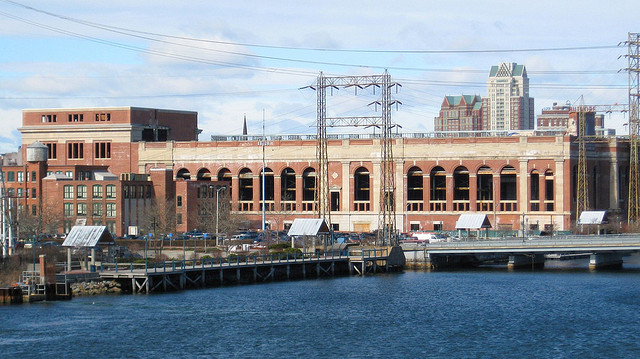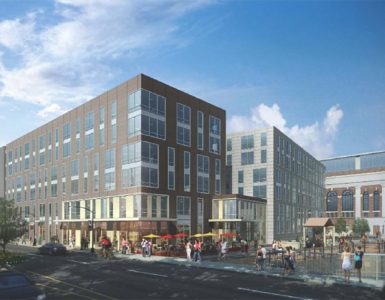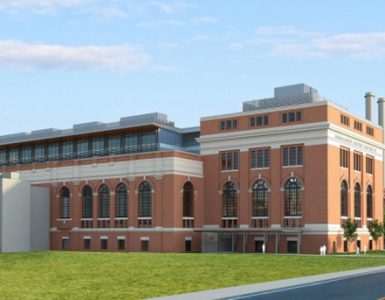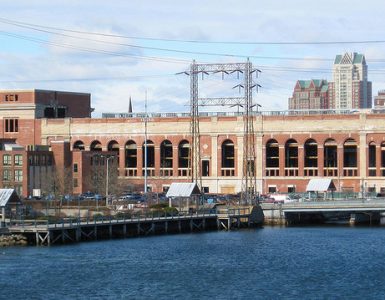
The University plan includes student housing, retail, a URI/RIC nursing school, administrative offices for the University, a new parking structure, and additions to the riverwalk. The vacant South Street Power Station would be a redeveloped, student housing built on a parking lot along Point Street, and the parking garage across Point Street.
[box style=”alert”]Update: Brown has a Press Release up on their site including a link to an Economic Analysis. [/alert]The following letter from Brown University President Christina Paxson, was forwarded to me by a member of the Brown Community:
I am writing to share news that Brown, together with the University of Rhode Island (URI) and Rhode Island College (RIC), is exploring the possibility of partnering with private developer Commonwealth Venture Properties on a comprehensive redevelopment project in Providence’s Jewelry District.
The centerpiece of the project is a renovation of the former South Street Power Station located at 360 Eddy Street, known as “Dynamo House.” Approximately one-half of this space (about 120,000 square feet) would be leased by Brown University for administrative and educational programs; the other half would be leased by the University of Rhode Island and Rhode Island College to house a shared nursing education program. The proposed project also includes an apartment building suitable for graduate, medical and advanced nursing students; retail space; space for start-ups and other small technology-based companies; and a new parking garage.
This week, a joint resolution was introduced in the General Assembly that, if passed, endorses the project in concept and enables URI and RIC to work over the coming months with the developer on a long-term lease agreement, which would require approval by the State Properties Committee and the General Assembly in the next session. The Brown Corporation has endorsed the concept, directing the administration to enter negotiations with the developer on a long-term lease. Assuming the details of these leases are negotiated successfully, we anticipate that construction and renovation would begin in 2014 and the facility would be ready for occupancy in 2016.
The proposed project has a number of attractive features. Medical education in Rhode Island will be strengthened by placing a first-rate nursing education program across the street from Brown’s Warren Alpert Medical School. The Jewelry District will be further revitalized by restoring an iconic Providence landmark to productive use and adding new residential and retail space to the neighborhood. The extensive planning that we undertook this last year emphasized the need for additional space on College Hill to accommodate future academic growth. As Brown moves some of its administrative functions to the Jewelry District, it will free up space on College Hill for core academic activities. In the coming months, as we explore this project with our partners, we will determine which areas and functions are best suited for relocation to this newly renovated facility, and the best uses for the space that is made available on College Hill.
Although this is an exciting project, there are still many details to be worked out in the coming months as the leases are negotiated and specific plans for the space are developed. We will keep the community apprised of this project as it proceeds. I am grateful for the enthusiasm and good will that URI, RIC, Commonwealth Venture Properties and officials in Providence and Rhode Island have demonstrated through the initial planning stages. Special thanks to Governor Chafee ’75, Mayor Taveras, Senate President Paiva Weed and Speaker Fox for their leadership. I look forward to continuing to work collaboratively with the city and state, and I am optimistic about the project’s success.
As currently envisioned, the proposed mixed-use complex would include:
- up to 120,000 square feet of space in the redeveloped South Street Power Station for a RIC/URI shared nursing education center;
- 120,000 square feet of space in the former Power Station for Brown University, to be used initially for administrative offices, freeing up College Hill campus space for core academic growth;
- a new, 150,000 square-foot apartment-style student residence for approximately 296 graduate, medical, and upper-level nursing students, to be built on the parking area of Davol Square;
- 15,000 square feet of ground-floor restaurant and retail space in the new residential building;
- 20,000 square feet of space for start-ups and other small technology-based companies;
- a new parking structure with 600 parking spaces located on a surface parking area on Point Street, south of Davol Square; and
- improvements to the public space along the Providence River and connection to the new public park to be located in the area made available through the relocation of Interstate 195.
The total project cost is estimated to be $206 million and is expected to be financed through a combination of previously committed state historic tax credits, new federal historic tax credits, private debt/private equity, and public support for the parking structure. Long-term lease commitments from Brown for approximately half of the space and from the state for the shared nursing center will enable to project to move forward.





renders!!
At least this is not on College Hill. But the continuing expansion of non-profits in Providence is very disturbing. City spending and taxes remain way too high and continue to discourage private businesses — which the city must have to recover from its current near-bankruptcy condition. The tax-exempt/for-profit balance is seriously broken and is getting worse. It’s also disturbing that state tax credits may be applied. Brown has more than sufficient funds to pay for this without taxpayer assistance. Both the state and city politicians remain clueless about how to regenerate a for-profit based economy for the state and the capital city. This short-term window dressing will fool the usual voters at election time, but in the long term it’s more of the same lipstick on the same sick state and capital city pigs.
Bill, I believe that comment belongs on the projo comment section.
This project isn’t just an expansion of non-profits. I’m not sure if you caught the details, but the private development piggybacking on this expansion is considerable, and justifies whatever investment we collectively have made into it. Keep in mind, Brown is LEASING the space, they won’t own it, so regular tax code should ultimately apply to this development. The residential project is 100% private, so it will also be taxed accordingly. There will be restaurant space, which will be a private business, also paying taxes and creating some jobs. I just don’t think your argument applies to this project. Actually, the biggest question mark here is the parking garage. I’m not sure if the city’s involvement is tied in any way to the courthouse garage project, but it could be, and I’m curious to see how long it’ll be until we find out.
“Continuing expansion of non profits” is a good thing. More education more jobs more stuff going on in the city are good things, period.
What is bad is over-reliance on property tax, combined with policies that concentrate in cities like Providence certain problems and expenses that should be borne by our entire society.
As a Wickenden St. resident who frequently walks to/through the Jewelry District, this is a dream project. The pedestrian connection as you cross the Point Street bridge can be very off-putting as you are greeted on the other side by two huge surface parking lots, a massive abandoned building, and an industrial power plant. I really can’t wait to see renderings of the restaurant and retail space as well as the “improvements to the public space along the Providence River”. The Jewelry District is in dire need of more good public spaces and small businesses.
David Rocha,
You make some interesting points. Ultimately, we will have to study the details, if they are made public.
This private aspects of this project suggest another trojan horse of sorts, like the proposed Gilbane “apartment building” [Brown dormitory] on Thayer Street. The Gilbane project effectively gives Brown a dormitory in a place where city regulations would have prevented Brown from building, and serves as a precedent for the further and dramatic similar changes in that area that the city and Brown are already proposing. Gilbane has been seeking tax concessions for that project from the outset.
In other words, is the private aspect of this project there because of a need for public subsidies (via tax credits)? Is the project overall driven by a need to create the appearance of economic activity before the next election cycle? Or the need to prop up the unionized construction industry with largely public funds? Or something else? Again, more details may shed some light. I suspect that the potential tax receipts will be far less than would appear now, by reason of concessions (tax stabilization agreements and the like) and market anemia/resistance.
Interestingly, does this project take any wind out of the suggestions for rehabbing the “superman” building?
Both the Thayer and Dynamo building would be taxed entities… Developer for the project developed GTECH building.. A+
Even if the Thayer Street building is exclusively marketed to and used by students, it will be a privately owned apartment building, not a dorm. The owner of the building will make a profit and pay taxes. Brown benefits by not having to use its endowment to construct residential units. The same would be true for the power station property. A new apartment building would be constructed on an existing surface parking lot on the site that would be owned by a private entity and marketed to students. What’s the alternative, wait for a fictitious commercial user to show up with deep pockets? What if none materializes for 20- or 30-years? Should we wait for the building to deteriorate to a point where would have to be demolished?
Peter,
All Brown dorms (and other non-core activities) should be paying taxes, but Brown’s state tax exemption is far more broad than similar exemptions in other states. One of the more amazing things about this grossly mismanaged state is the amount of money that the state allows Brown (and other larger tax exempts) to retain through its tax exemption — as compared to similarly situated tax exempts in other states. Brown’s lobbyists work very hard, below the radar, to ensure that this does not change.
We don’t have sufficient details to evaluate this proposed power station deal completely, but it seems in effect to be effectively a state-guaranteed and partially state and federally-funded project. If the state’s and city’s spending so raises taxes to all but exclude private investment, as is the case now, then the political temptation to rely on public funding of large development projects like this and others increases.
What is the alternative, you ask? The alternative is our development of the self discipline to reduce wasteful public spending and dramatically lower taxes so that we can again attract private investment in a serious way. Now, private investment unassisted by public contributions and guarantees largely recoils at siting in RI. Projects like this provide short-term jobs and ribbon-cutting ceremonies, but strengthen the already excessive political power of the tax exempts like Brown and otherwise kick the can of the fundamental underlying economic problems down the road and make them worse.
Bill,
Why don’t you start an awareness campaign against the city/state/Brown? You have the Internet. People love to expose corrupt cities and corporations, so I bet you could go viral. Complaining about 1 project one a forum that loves this city won’t do you any good though.
Otherwise.. I look forward to this. I remember the UrbanPlanet days when so much was going on, and then things changed any many projects or ideas were abandoned. This building is unique and I can picture a beautiful re-use of it and am excited. 🙂 I hope this is the beginning of more investment because you can’t tax exempt jobs and residents. You can however stop paying 10 people at city hall 1 million dollars to do what one person could do on a $65k salary 🙂 Property taxes should not make or break a historic revival such as this one
I think Bill is right that high commercial property taxes in Providence are a real problem that discourages needed private investment, but I would be more interested if his alternative of cutting spending and “dramatically reducing taxes” – an easy thing to say – was supported by noting programs where spending should be substantially reduced. On schools, fire, police? On garbage pickup? On summer swimming pools for kids? On arts/culture/tourism? Or maybe the $16 million Providence might kick in for the 600 car garage for this project?
Whatever the specifics are as far as private / public / tax exempt or not, IN THIS PARTICULAR CASE, this is a Godsend. This is a marquee building that has been available for years with no takers. This site is a gateway from several directions and needs to be refurbished in any capacity that gets it done. Remember almost no one else has wanted this building and its inherent problems – or — if they did – has been able to secure the financing etc to do the job. Just let this get done as long as it is a good usage plan — which I believe this is — so that the rest of that area will be whole an viable for additional development and usage.
I’m not sure if its just taxes. The New York and New Jersey area has stifling taxes, where real estate tax is just one from a large menu. There are several factors, which make development in Providence difficult.
Construction costs are not that much lower than Boston or even New York. Even if real estate tax rates are lower, housing valuations are much higher in NY and NJ. For comparable residential and commercial properties Rhode Islanders get off cheap in comparison. Providence area salaries are much lower than Boston or New York. Similarly commercial or residential rents are significantly lower in Providence than elsewhere in the northeast. The result is that it’s difficult for any project to break even, not to mention be profitable.
Barry, you touched on a significant added cost, which is parking. It’s not just the city chipping in for a 600-space garage, but also the added construction cost to any developer who wants to construct a new building.
Approximate costs:
Surface parking space – $15,000 each
Above-grade structured parking space – $25,000-$30,000 each
Below-grade parking space – $40,000+ each.
At the last Zoning Board meeting a developer who wants to build a 30-unit apartment building with ground floor retail asked for relief from the parking minimums, because it was only possible to excavate for one cellar for parking due to a problematic below-grade water condition. Jewelry District (JD) neighbors objected and wanted to hold the developer to the (artificial) minimum standard, which for downtown are 1.5 spaces per unit ÷ 50%. For that project just for the residential, not including retail, it would require 23 spaces x $40,000 = $929K for parking.
Isn’t the JD a walkable downtown neighborhood and doesn’t RIPTA offer good bus service with the #1 and #3 routes plus aren’t there a few Zip Car locations in the neighborhood? Given the 2-3% vacancy rate for downtown apartments, if developers like the JD developer could save a million on costs, there would likely be a lot more new construction downtown that would be unaffected by real or perceived high real estate taxes.
“Brown’s lobbyists work very hard, below the radar, to ensure that this does not change.”
Meh. They don’t -have to-. Brown’s charter predates the state constitution, and the state has no constitutional authority to levy a tax on Brown, as far as I understand.
I’m also frustrated by the city’s fiscal misspending. I don’t think it’s realistic that Rhode Island could -EVER- be a ‘low tax’ state, given that we’re urban, and cities require significant public investment (they also generate a tremendous amount of economic activity). What bothers me about Providence is the -mismanagement- of things, When I see city workers painting a mural while the storm drains right below them are literally overflowing with sand, I get upset. Now, I’m sure there’s no photo-op or grant money to dig out a storm drain or fix a leaky pipe, but that should be the focus.
If the state is going to get all these jobs and enjoy the benefit of having Providence around, it’s time we looked at ways to stop the ‘burbs from externalizing their costs to us. We hold the seat of government, the colleges, the hospitals, the large non-profits, etc., but the Barringtons and Burrilvilles of Rhode Island benefit from them. It’s time for a solid statewide ‘funding formula’ that serves to enhance the city-state that we are. Maybe we do a tiny statewide tax on square footage, maybe we reform the income taxes, or maybe we direct a portion of revenues to where they originated from instead of where the people who earn them rest their heads at night.
Would have been a great use to house street-cars.
PBN: ‘Eyesore’ pitched as job catalyst
ProJo: Providence agency considers condemning Power Station property as a step toward redevelopment